I have used the OS:Coil:Cooling:Dx:SingleSpeed object to model ASHP which uses the extraction air from rooms as a heat sink, instead of using the external air. I have used a slightly different procedure to determine the coefficients needed for the performance curves since the manufacturer data reflected the machine working conditions and they were not useful for the application in the excel sheet "Curve Fit Tool_Cooling_Air" found in E+ folders.
Because I was not sure of the results of this approach, I decided to test the model with a simple box. The idea is to use particular conditions (for outdoor and indoor air, loads configuration, etc) in order to obtain constant values for thermal and electrical power of the machine. Obtaining in the output the temperatures which are the dependant and independent variables of the performance curves, it is possible to recalculate the curves values, using the coefficients and the simulation results.
So, I tried to lure the software into applying the DX coil model with the temperatures I would have in the real operation scheme: I altered the weather file (with elements), in order to have the "room conditions" for %RH and T, so the model would have used those instead of the standard outdoor conditions for the evaporator side. Then I inserted in the air loop, just between the outdoor air mixer and the DX coil, an electrical reheat and an electrical humidifier. In this way, I could replicate the outdoor air conditions I wanted to test.
Given the fact that what I obtained is not in good agreement with what I was expecting, my question is: is someone already have approached a similar problem? I am not sure I can replicate the real machine behavior using the OS:Coil:Cooling:Dx:SingleSpeed model proposed in the software.




